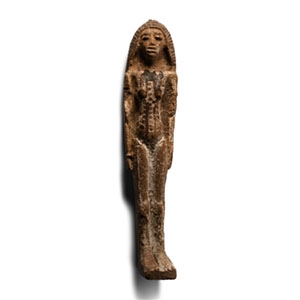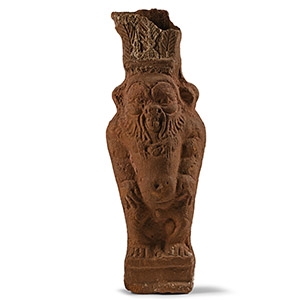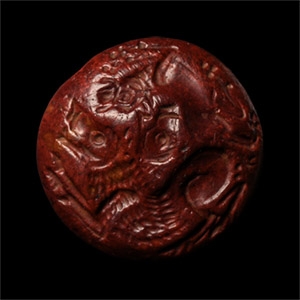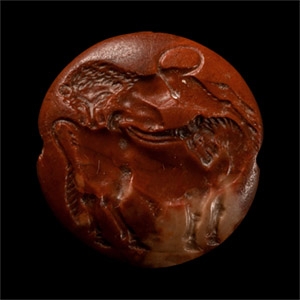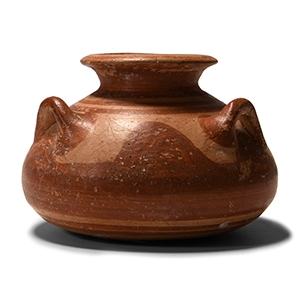Home > Auctions > 4 - 9 March 2025
Ancient Art, Antiquities, Books, Natural History & Coins
From the estate of the late designer Anthony Powell (1935-2021).
This lot has been checked against the Interpol Database of stolen works of art and is accompanied by search certificate no.12497-230640.
This lot has been cleared against the Art Loss Register database, and is accompanied by an illustrated lot declaration signed by the Head of the Antiquities Department, Dr Raffaele D’Amato.
Cf. Arnold, D., Temples of the Last Pharaohs, New York/Oxford, 1999, pp.127–28, fig. 86, for a similar representation.
Representations of fecundity figures can be traced from the Old Kingdom through to the Roman Period. These figures serve as divine embodiments of Egypt’s fertile productivity and are commonly depicted in series on the lower registers of temple walls, symbolising the fertility of each province. Historically, they have often been mistakenly referred to as the ‘Nile God’; however, the term Hapi, which sometimes identifies these figures, actually refers to the inundation rather than the River Nile itself, highlighting the source of Egypt’s fertility.
Smith family collection, Cambridge, UK since 1949.
Private UK collection since 1978.
Accompanied by a scholarly note by Egyptologist Paul Whelan.
This lot has been checked against the Interpol Database of stolen works of art and is accompanied by search certificate number no.11033-183985.
This lot has been cleared against the Art Loss Register database, and is accompanied by an illustrated lot declaration signed by the Head of the Antiquities Department, Dr Raffaele D’Amato.
Cf. for a near identical example from Memphis and now in the Walters Art Museum, Baltimore, inventory no. 54.395.
The moon god Khonsu (whose name means 'wanderer', referring to the passage of the moon across the sky) is known as a blood-thirsty sky-deity in the Pyramid Texts. In New Kingdom Thebes, however, he was regarded as a far more benevolent deity, being the child of Amun and Mut, and provided with his own temple at Karnak. There, he was considered to control destiny. Khonsu can appear in human form with a side-lock of youth, wearing an enveloping garment, and holding royal regalia, and also as a falcon-headed man with the full moon and crescent new moon headdress, as with this fine example. In his falcon-headed form he frequently holds an ankh symbol and a was-sceptre, for which the hands of this piece were drilled to accept the god's well-known attributes.
From a 1940s collection based on the base and remains of label verso.
From the Keane private collection, Kent, UK.
This lot has been checked against the Interpol Database of stolen works of art and is accompanied by search certificate number no.12479-229477.
This lot has been cleared against the Art Loss Register database, and is accompanied by an illustrated lot declaration signed by the Head of the Antiquities Department, Dr Raffaele D’Amato.
Cf. Daressy, G., Catalogue général des antiquités égyptiennes du Musée du Caire N° 38001-39384 Statues de divinités, Cairo, 1906, pl. XLVIII no.38954, for a complete example with an elaborate collar; Tiribilli, E., The bronze figurines of the Petrie Museum from 2000 BC to AD 400, GHP Egyptology 28, London, 2018, p.117, for a discussion of this statuette type.
Neith is one of the oldest ancient Egyptian deities with roots in the Early Dynastic Period. She is often depicted as a woman wearing the Red Crown of Lower Egypt and carrying a sceptre, symbolising her divine power. As a warrior and mother figure, Neith embodies creation, wisdom, and warfare. Her cult rose in prominence during the Ramesside Period as she became linked with the sun god. The primary centre of her worship was the city of Sais in the western Nile Delta, which became a significant religious and political hub during the 26th Dynasty (664–525 B.C.). Kings of this era claimed her as their protector and identified with her in royal titles.
Acquired on the London art market.
Ex 'K' collection, 1990-2020s.
This lot has been cleared against the Art Loss Register database, and is accompanied by an illustrated lot declaration signed by the Head of the Antiquities Department, Dr Raffaele D’Amato.
Cf. The Royal Ontario Museum for a similar figure (inv. no. 910.17.14); cf. Daressy, G., Catalogue général des antiquitéségyptiennes du Musée du Caire N° 38001-39384 Statues de divinités, Cairo, 1906, pl. XXVII, no. 38479, for a similar example.
Amun-Min-Kamutef was a syncretic deity combining the attributes of Amun, the supreme god of the Egyptian pantheon, and Min who represents sexual procreation. The iconography of Amun's ithyphallic form Kamutef is essentially that of Min, and serves to emphasise the sexual prowess of the god. Kamutef means 'bull of his mother' and appears to refer both to Amun's sky-goddess mother in her cow form and to the bull's sexual prowess and strength.
Ex German private collection.
Acquired from Galerie BB-Antiken & Asiatika with stock reference no.366/08.
From the private collection of a Belgian collector.
Ex TimesAncient, Bristol, UK.
Accompanied by a copy of the Galerie BB-Antiken & Asiatika certificate dated 1 December 2008.
Accompanied by a copy of a previous catalogue entry.
This lot is accompanied by an illustrated lot declaration signed by the Head of the Antiquities Department, Dr Raffaele D’Amato.
For the name Nes-Khonsu, see Ranke, H., Die Ägyptischen Personennamen, Band I, p. 178, no.20.
Nes-Khnosu (and the variant Nesy-Khonsu) were common names during the Third Intermediate Period. However, the combination of the name and title in the dedication on this shabti is less common. It is possible that this shabti comes from tomb 339 at Deir el-Medineh in Western Thebes. The tomb was discovered by Bernard Bruyère in 1929 (Rapports préliminaires Deir el Médineh, Cairo, 1930, p. 89, 92), from where blue faience shabtis bearing the same dedication were recovered. Traditionally, chantresses were female performers who acted as dancers and rhythmic musicians. Like Nes-Khnosu, many were associated with temples and played significant roles in religious festivals.
From an old English deceased estate.
Property of a London, UK, collector.
This lot is accompanied by an illustrated lot declaration signed by the Head of the Antiquities Department, Dr Raffaele D’Amato.
The Erotica Collection Christian von Faber-Castell, Küsnacgt ZH, Switzerland, since the late 1970s.
This lot is accompanied by an illustrated lot declaration signed by the Head of the Antiquities Department, Dr Raffaele D’Amato.
Cf. Weber, W., Die ägyptisch-griechischen terrakotten, Berlin, 1914, pl.25, no. 251, for similar.
Christian von Faber-Castell (born 1950) is a renowned German entrepreneur and art collector, best known as a member of the prominent Faber-Castell family, famed for their iconic writing instruments. A passionate advocate for art and culture, Christian von Faber-Castell curated an extensive and diverse private collection of erotica spanning centuries and cultures. His collection reflects a deep appreciation for the interplay of beauty, sensuality, and artistic expression, bringing together rare and unique works that explore themes of intimacy and human connection. Pieces from this collection have been featured in notable exhibitions and are celebrated for their artistic and historical significance. This offering represents a rare opportunity to acquire works from one of the most fascinating and eclectic private collections of its kind. Bes became one of ancient Egypt's most popular apotropaic deities from the New Kingdom onwards. Despite his somewhat fearful appearance, Bes was the patron and protector of pregnant women and children and was also believed to protect from snakes.
From the late R. Priday collection, formerly of Brookmans Hall, Hertfordshire, UK, formed in the 20th century.
Accompanied by an academic report by Dr Raffaele D'Amato.
This lot has been checked against the Interpol Database of stolen works of art and is accompanied by a search certificate number no.12514-231463.
This lot has been cleared against the Art Loss Register database, and is accompanied by an illustrated lot declaration signed by the Head of the Antiquities Department, Dr Raffaele D’Amato.
Cf. similar seals in Betts, J.F., Corpus der Minoischen und Mykenischen Siegel, Band X, Die Schweizer Sammlungen, Berlin, 1980, no.41 (for the shape), p.84, and nos.150-151, pp.156, for similar lions; Boardman, J., Greek Gems and Finger Rings, Early Bronze Age to Late Classical, London, 1970 (2001), nos.138 [lioness suckling a cub], 178 [contorted lion], 193 [a contorted lion and a tree].
LATE HELLADIC, CIRCA 1400-1300 B.C. OR LATER
With Münzen und Medaillen A.G., Basel, prior 1980.
Accompanied by an academic report by Dr Raffaele D’Amato.
This lot has been checked against the Interpol Database of stolen works of art and is accompanied by search certificate number no.12465-228767.
This lot has been cleared against the Art Loss Register database, and is accompanied by an illustrated lot declaration signed by the Head of the Antiquities Department, Dr Raffaele D’Amato.
See similar seals in Betts, J.F., Corpus der Minoischen und Mykenischen Siegel, Band X, Die Schweizer Sammlungen, Berlin, 1980, no.218, p.193; Boardman, J., Greek Gems and Finger Rings, Early Bronze Age to Late Classical, London, 1970 (2001), nos.86 [lion attacking a goat also in red jasper], 138, 159 [agate lentoid],169 [lion attacking bull, from Mycenae],172, 182 for Minoan gems with similar scenes; see a lioness attacking a bull, in Museum of Fine Arts, Boston, lentoid shape seal (about 1470-1410 B.C.), accession no.23.576.
John H. Betts, Corpus der Minoischen und Mykenischen Siegel, Band X, Die Schweizer Sammlungen, (Berlin 1980) 194, cat. nr. 219, doubted by the author.
Acquired from Royal Athena Gallery, 2003.
This lot has been checked against the Interpol Database of stolen works of art and is accompanied by search certificate number no.11851-206833.
This lot is accompanied by an illustrated lot declaration signed by the Head of the Antiquities Department, Dr Raffaele D’Amato.
Cf. Sadberk Hanım Museum, Istanbul, for a very similar example.
Acquired in the mid 1980s-1990s.
Private collection, Switzerland, thence by descent.
Private collection, since the late 1990s.
This lot is accompanied by an illustrated lot declaration signed by the Head of the Antiquities Department, Dr Raffaele D’Amato.
Cf. a more elaborately modelled example in the British Museum under accession no.1884,1011.2.
Acquired in Europe before 1996.
This lot is accompanied by an illustrated lot declaration signed by the Head of the Antiquities Department, Dr Raffaele D’Amato.
Cf. Biers, W.R., The Archaeology of Greece. An Introduction, Ithaca-London, 1987, fig.8.63, p.236, for similar.
The typical 5th century B.C. terracotta female figurine was a standing or seated woman wearing a chiton and a himation. It usually represented the goddess Demeter, and it was a votive figure offered to the shrines or temples. Attica was one of the principal centres of figurine production, but Corinth continued to produce solid standing or seated females with moulded fronts and flat backs.
13 - 24 of 3546 LOTS

.jpg)
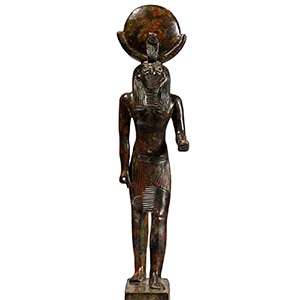
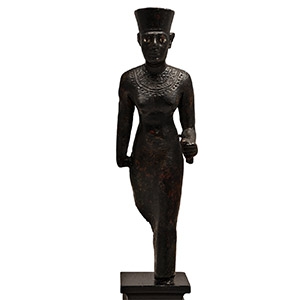
.jpg)

